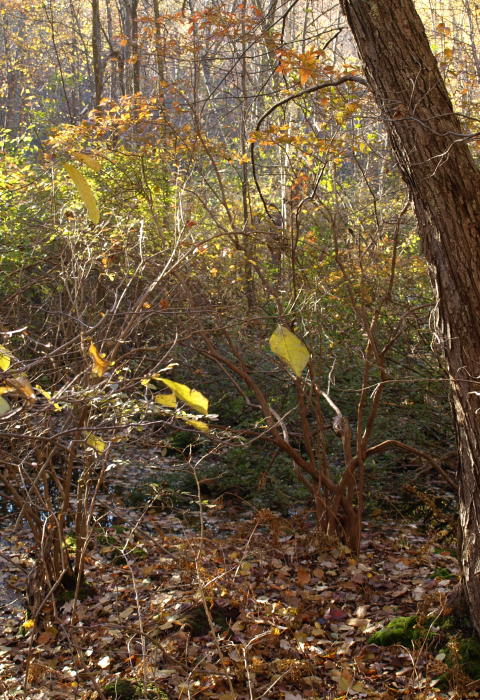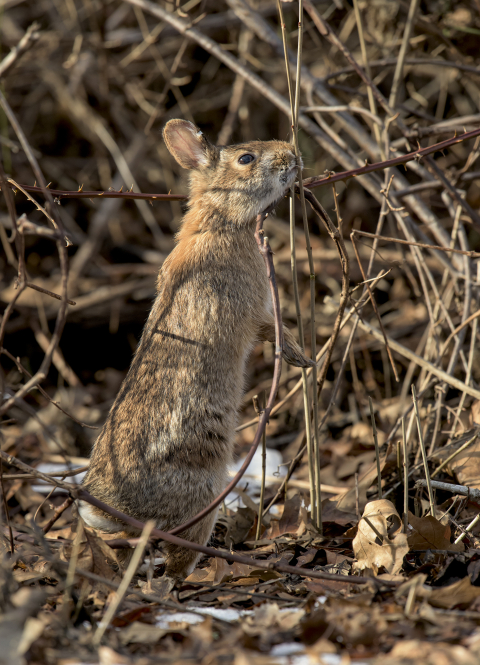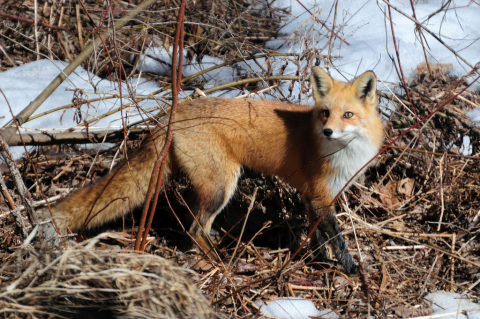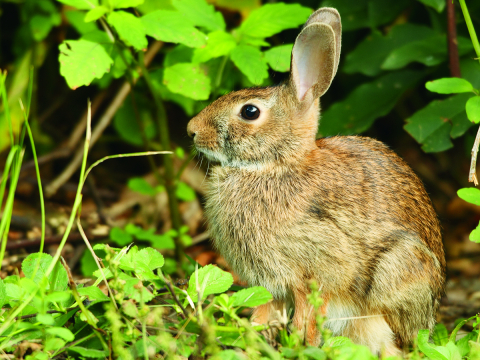Secretive, and Known by Many Names
The New England cottontail is also called a “brush rabbit” or “woods rabbit,” since it thrives in brushy thickets and small woodland openings with low, dense plant growth. Another name is “coney.”
Appearance and Size
The New England cottontail (Sylvilagus transitionalis) is 15 to 17 inches long and weighs around 2 pounds – about 20 percent smaller than the closely related eastern cottontail (Sylvilagus floridanus), introduced to the region by humans many years ago, and which now outnumbers the native rabbit. If you see a cottontail in your yard, it’s probably an eastern and not a New England cottontail.
Both rabbits have grayish brown fur flecked with black, and a white tail. Most New England cottontails have a small black spot on the forehead, while about half of all eastern cottontails have a white spot in the same place. The New England cottontail's ears are slightly shorter than those of the eastern cottontail and have black fur rimming the edge.
To differentiate between the two, scientists may examine a specimen’s skull shape and features, or analyze DNA from body tissues or fecal droppings. Researchers also use DNA analysis of rabbit fecal pellets to determine the presence in a given habitat of New England or eastern cottontails, or both.
Range and Routine
New England cottontail home ranges vary from 0.5 to 8 acres, with males’ territories larger than females’. An individual spends the day among weeds, shrubs, and young trees. It may crouch at the base of a large tree, where blackberry, greenbriar, multiflora rose, mountain laurel, or other shrubs offer good hiding cover. Brushy wetlands are important habitats.
At dawn and dusk, rabbits move about for several hours feeding.
In summer they eat shoots, stems, leaves, flowers, and seeds of many plants. In winter they switch to bark, twigs, and buds of trees and shrubs. Snow on the ground may cover up low vegetation while letting rabbits reach higher to access other foods.
Reproduction
New England cottontails breed from March into September. A healthy female may bear several litters a year. The gestation period for each litter is about a month. Before giving birth, a pregnant cottontail makes a nest in brush or dense vegetation on the forest floor. She digs a shallow depression in the ground and lines it with grass and fur from her body, then adds a covering of leaves and twigs.
A typical litter has five or six young, known as “kits.” Cottontails are born with their eyes shut. At times, the mother goes off to find food for herself, then sneaks back to the nest to nurse her young. Kits develop rapidly and may go off on their own two weeks after they were born. Females can breed and become pregnant soon after delivering a litter.
A Short Life Full of Peril
Research on eastern cottontails shows that about a quarter of all individuals live for two years; the average lifespan is 15 months. Figures for New England cottontails are probably similar.
Rabbits die from diseases or when hit by cars while crossing roads. An important part of the natural food chain, they are killed and eaten by coyotes, foxes, bobcats, fishers, weasels, hawks, and owls. Biologists studying New England cottontails in southern New Hampshire found that predation by coyotes and red foxes was the most common cause of death among the radio-equipped rabbits they monitored.
Living in thick young forest and shrubland makes it less likely that a cottontail will become a predator’s meal – and more probable that a healthy population will persist on a site over the years. Thick cover is especially valuable in winter; without it, a brown rabbit would stand out against a snowy background and get picked off more easily by a predator.
Falling Numbers
The New England cottontail was probably most abundant in the early 20th century, after many farms in the region were abandoned and had grown back in shrubs and small trees. Today, the population is falling and the species’ range is shrinking as young forests and shrublands transition into older woods, as humans develop formerly wild lands, and as we prevent natural disturbance processes from replenishing the supply of young forest and shrubland.
Competing Cottontails
In the small fragmented habitats that exist in much of southern New England, a key physical difference may give the introduced eastern cottontail an edge over the native New England species: the eyes of an eastern cottontail are larger than those of a New England cottontail.
This feature probably arose because the eastern cottontail evolved in more-open grassland settings in Midwestern North America, where detecting predators at a distance conferred a survival advantage. New England’s "woods rabbit" evolved in a more-forested setting, so it didn’t develop such large eyes because it was always close to patches of thick cover. Now, with their larger eyes and likely more acute vision, eastern cottontails can venture farther away from hiding cover, which lets them take advantage of more and different foods and still dart back to safety if a predator threatens.
Wildlife scientists are studying ways to make young forest and shrubland that will strongly benefit New England cottontails rather than nonnative eastern cottontails. Approaches include leaving more trees during timber harvests and making small, thick openings in forested areas.
Best Management Practices for the New England Cottontail provides detailed advice on creating and renewing habitat. A state-oriented guide explaining how to make habitat in New York is also pertinent throughout the species' range.
More Help for New England's Rabbit
Conservationists are breeding New England cottontails in zoos and on island refuges and relocating their offspring to areas of early successional habitat in the wild. And conservation partners mimic natural disturbances by using a variety of habitat management techniques to create and refresh young forest and shrubland on state and federal lands, municipal forests, land trust properties, and private holdings.
In 2016, the U.S. Fish and Wildlife Service created the Great Thicket National Wildlife Refuge in ten separate parts of the New England cottontail’s six-state range. The Nature Conservancy donated the first land for the refuge, 144-acre Nellie Hill Preserve in New York’s Hudson River Valley. (A fact sheet answers questions about land acquisition for the new refuge.)
Since small populations of wildlife can be endangered by diseases such as Rabbit Hemorrhagic Disease, biologists carefully monitor populations of New England cottontails.
Private Landowners are Key
Refuges and wildlife management areas offer habitat to the New England cottontail and other animals, both rare and common, that also require young forest and shrubland. But because so much land in the Northeast is privately owned, ongoing habitat creation by private landowners is crucial to the future of the cottontail and many other wild creatures.




